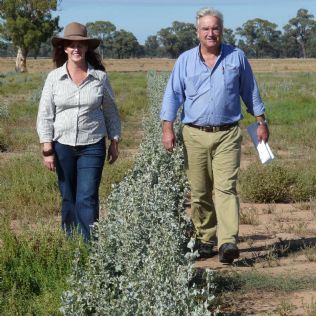
ESTABLISHMENT OF SALTBUSH BENEFITS FROM PROVEN CEREAL SOWING TECHNOLOGY
Saltbush for farm systems
The Weekly Times, April 15, 2010
SALTBUSH is a viable feed alternative in low-rainfall environments, writes KIM WOODS
Pastoral-zone landholders are turning to saltbush as an alternative to perennial pasture in drier climates. And, with direct seeding costs about 10 per cent of the cost of planted seedlings, saltbush is proving cost effective over large areas. It is also being lauded as a structural adjustment option for retired land on the edge of irrigation areas. Saltbush is a low-input plant that can free up water for more-profitable crops. A direct-seed trial  established last year on a corporate-owned farm, Somerleyton, at Deniliquin in NSW has proven the plant needs little moisture. The trial was grown on spring rainfall of just 10mm. Murray Catchment Management Authority vegetation co-ordinator Martin Driver said saltbush was ideal for areas of low return for irrigation costs. Martin said the plant was also an option for degraded soils. Saltbush gives succulent high-protein green feed all year for sheep and cattle but it is unpalatable to kangaroos. As a deep-rooted perennial, old man saltbush has the added benefit of being able to use sub-soil moisture down to 5m. It provides shelter for sheep off-shears and is an effective windbreak to reduce soil erosion. “In the past, it has been a natural reaction by landholders to use the worst soil types for saltbush,” Martin said. “But it needs to be treated like any other crop. “Saltbush will not persist in deep sand and I’d be nervous on lighter country as rabbits could burrow underneath the plants.”
established last year on a corporate-owned farm, Somerleyton, at Deniliquin in NSW has proven the plant needs little moisture. The trial was grown on spring rainfall of just 10mm. Murray Catchment Management Authority vegetation co-ordinator Martin Driver said saltbush was ideal for areas of low return for irrigation costs. Martin said the plant was also an option for degraded soils. Saltbush gives succulent high-protein green feed all year for sheep and cattle but it is unpalatable to kangaroos. As a deep-rooted perennial, old man saltbush has the added benefit of being able to use sub-soil moisture down to 5m. It provides shelter for sheep off-shears and is an effective windbreak to reduce soil erosion. “In the past, it has been a natural reaction by landholders to use the worst soil types for saltbush,” Martin said. “But it needs to be treated like any other crop. “Saltbush will not persist in deep sand and I’d be nervous on lighter country as rabbits could burrow underneath the plants.”
The 16ha site at Somerleyton is part of 2500ha of revegetation established for biodiversity in the Murray catchment. The saltbush was direct seeded at a cost of /ha last June after 25mm of rain the previous month. Several millimetres fell the day after sowing followed by a total of 10mm to the end of October. Mr Driver said weed control was always critical with saltbush establishment, and barley grass and secondary weeds had been sprayed.
Three direct-seeding machines were used in the trial, sowing at 500g/ha on 3m-wide spacings – a scalping direct seeder (Burford unmodified), a Jenke parallelogram tyne and a Primary Sales modified tyne. “The traditional scalping machine produced some good results,” Martin said. “But the Primary Sales modified tyne gave a much more consistent strike when moisture was limiting, and that’s a big factor. “The advantages of this machine were quite pronounced in October when it was dry. “Plants sown with the other two machines were struggling.” Martin said the saltbush had transformed the paddock from bare to grazeable in nine months. By February, the average seedling density for the Primary Sales machine was 12,300/ha compared with 900/ha for the Jenke and 4800/ha for the Burford. On a dry-matter-per-hectare basis, the Primary Sales seeder recorded 1845kg. “We were flabbergasted to get a result, let alone such a good result,” he said. “I would have no qualms about grazing this site now.
“I would have no qualms about grazing this site now.
“We now have a crop that will last up to 100 years – it’s a great result.
The 1845kgDM/ha is stored carbon above the ground, which makes the enterprise look more exciting.” Martin said the next step would be either allow volunteer grasses to grow or sow a feed (cereal) crop inter-row. “More people are looking at direct-seeding saltbush on multiple combine widths so they can winter crop in between,” he said. “The stubble can be grazed with the saltbush. “The ideal width in native grass country is 10-15m apart in 20-40ha blocks. “Otherwise 6-10m is a good spacing if there is an improved pasture base.” Martin said lucerne was not a good match for saltbush as the lucerne was preferentially grazed by stock. He said native grasses and saltbush were a “brilliant combination”.
Corowa farmers Andrew and Delwyn Clifton have sown 14ha of saltbush on 6m-wide spacings. “We feed canola hay every second day and leave a gate open to a stubble paddock for the carbohydrate component,” Delwyn said. “We put the stock in when the plants were six-and- a-half months old and monitored it. “It took three days for the sheep to get a liking for it, (and) the grazing promoted growth, making the plants stronger.” Delwyn said a summer storm of 71mm had resulted in the saltbush growing rapidly. “The message is farmers don’t need a large acreage of saltbush for it to play a valuable role in farming systems,” she said. Encouraged by the success of the saltbush plantings, Martin plans to establish saltbush in the corners of cropping paddocks. Martin said saltbush needed to be grazed hard to control excess growth after summer rain. Deniliquin direct seeding contractor Stuart Sizer said seed quality was critical. He suggested landholders carry out a germination test before sowing. Stuart said fresh seed germinated within five days while seed stored for several years germinated at seven to eight days.”Using the strongest and most vigorous seed will pay off,” he said.


